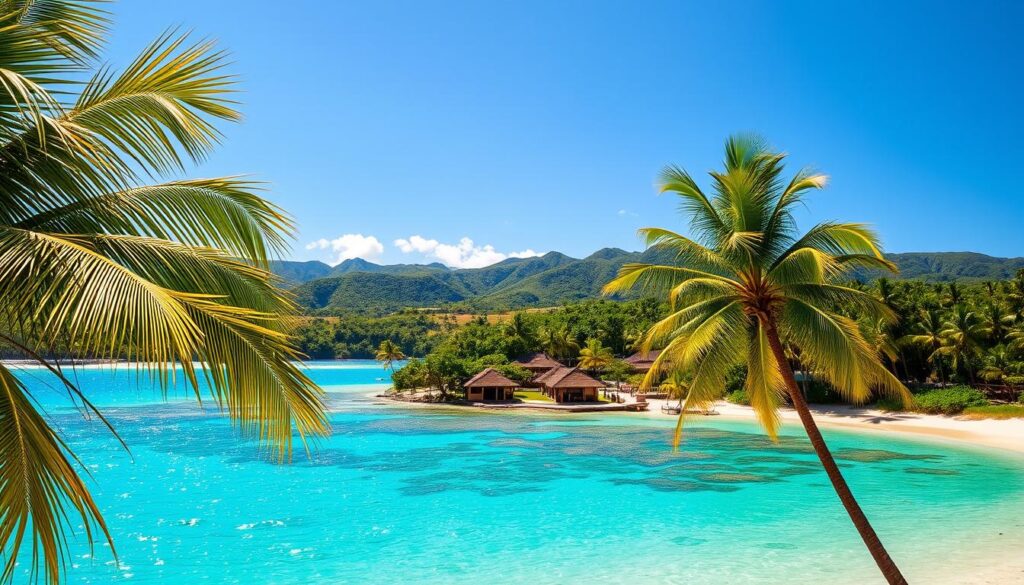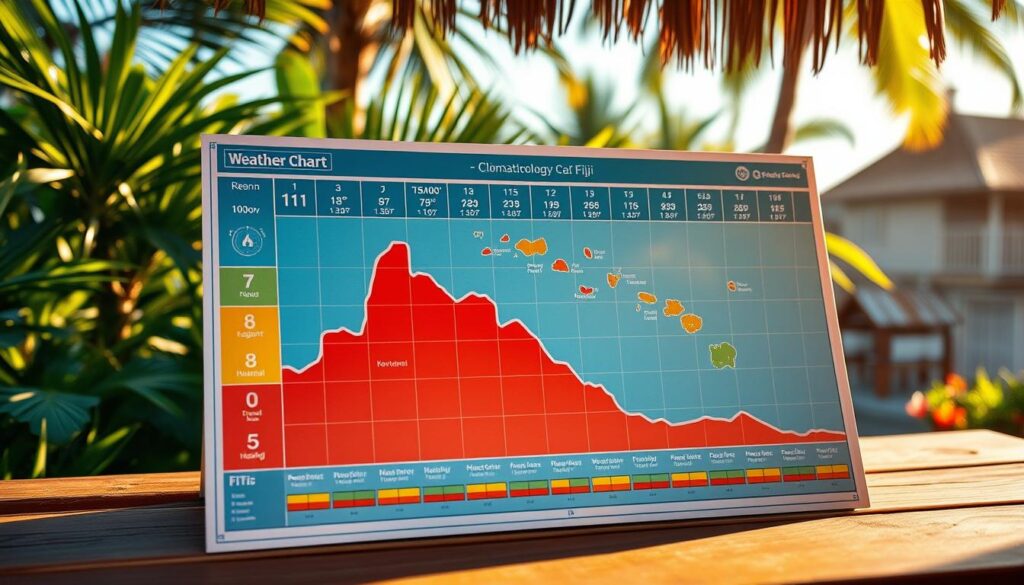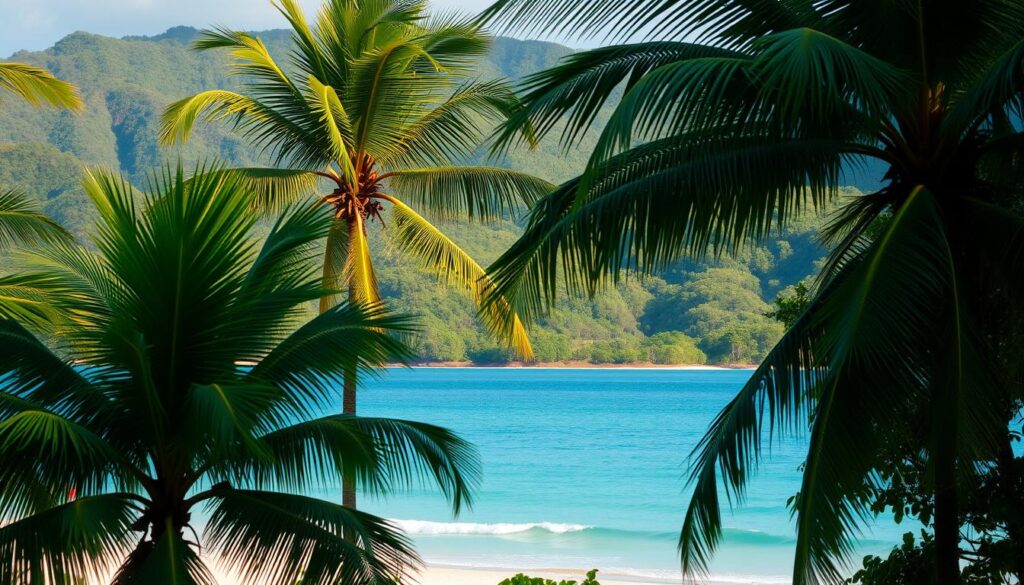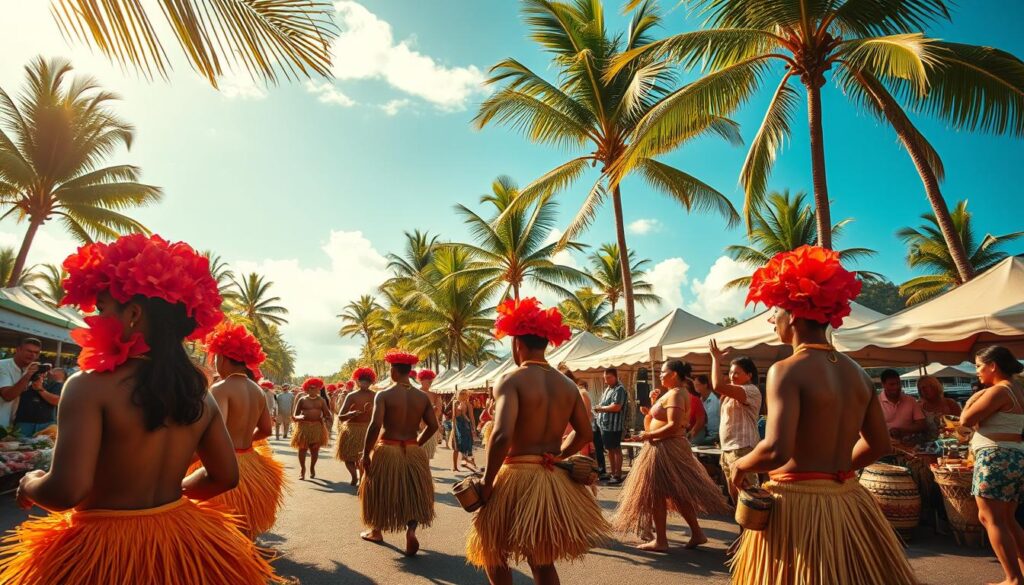Fiji is a tropical paradise in the Pacific, drawing millions of visitors yearly. Its year-round tropical climate makes it great any time of the year. Yet, the experience can vary greatly based on when you go.
To fully enjoy Fiji, it’s key to know its weather patterns, avoid crowds, and catch local festivals. Whether you want a calm escape or an exciting journey, timing is critical.
Key Takeaways
- Plan your trip according to Fiji’s weather patterns for a more enjoyable experience.
- Avoid peak season to steer clear of crowds.
- Fiji’s festivals offer a unique cultural experience.
- Researching Fiji travel tips can help you make the most of your visit.
- Choosing the right time to visit Fiji is critical for a memorable trip.
Understanding Fiji’s Climate and Seasons
Travelers need to know about Fiji’s tropical climate and seasonal changes. Fiji’s climate is warm all year, with two main seasons.

Fiji’s Tropical Climate Explained
Fiji’s climate is warm, with temperatures between 22°C and 30°C (72°F to 86°F). This makes it great for those who love the sun. The southeast trade winds cool the air during the dry season.
The tropical climate of Fiji also means high humidity, mainly in the wet season. This season sees more rain and a chance of tropical cyclones. Knowing this helps plan your trip better.
The Two Main Seasons: Wet and Dry
Fiji has two main seasons: wet and dry. The dry season, from May to October, is the best time to visit. It’s dry and cooler, perfect for outdoor fun.
The wet season, from November to April, is hotter and rainier. It’s tough due to cyclones and rain, but it’s green and less crowded.
How Climate Change Is Affecting Fiji’s Weather Patterns
Climate change is changing Fiji’s weather. Sea temperatures rise, leading to more intense cyclones. This hurts the environment and tourism.
Knowing how climate change affects Fiji helps plan your trip. It also supports sustainable tourism, helping Fiji’s future.
Best Time to Visit Fiji: Weather, Crowds & Festivals Explained
Choosing the best time to visit Fiji depends on what you like. Weather, crowds, and festivals play big roles. May to October is often the best, with good weather and fun festivals.
Overview of Ideal Visiting Times
Fiji’s weather is warm all year. But, different seasons offer different experiences. The dry season, from May to October, is the best for its sunny and dry days.
Key Highlights of the Dry Season:
- Comfortable temperatures ranging from 22°C to 28°C (72°F to 82°F)
- Low humidity
- Minimal rainfall
- Ideal conditions for outdoor activities like snorkeling, diving, and hiking
Factors That Influence the Best Time to Visit
Several factors can influence the best time to visit Fiji, including:
- Weather: Fiji experiences a tropical marine climate, characterized by warm temperatures and distinct wet and dry seasons.
- Crowds: Peak tourist season coincides with the dry season, making popular destinations more crowded.
- Festivals and Events: Fiji hosts various cultural festivals throughout the year, such as the Hibiscus Festival, which can be a major draw for visitors.
A travel expert notes, “Fiji’s cultural events are a significant part of its appeal. Timing your visit to coincide with one of these festivals can greatly enhance your experience.”
“Fiji is a paradise for those who love the outdoors and cultural experiences. The best time to visit is when you can enjoy both without the hindrance of rain or excessive heat.”
Month-by-Month Weather Overview
Knowing Fiji’s weather month by month helps plan your trip better.
| Month | Average High Temperature (°C) | Average Low Temperature (°C) | Rainfall (mm) |
|---|---|---|---|
| January | 30 | 23 | 280 |
| February | 30 | 23 | 260 |
| March | 29 | 22 | 240 |
| April | 28 | 21 | 180 |
| May | 27 | 20 | 100 |
| June | 26 | 19 | 80 |
| July | 25 | 18 | 60 |
| August | 25 | 18 | 70 |
| September | 26 | 19 | 80 |
| October | 27 | 20 | 120 |
| November | 28 | 21 | 180 |
| December | 29 | 22 | 230 |

Peak Season in Fiji: June to September
June to September is Fiji’s peak season. It’s known for dry and sunny weather, perfect for those who love the outdoors. During these months, Fiji is in its dry season. This means low humidity and pleasant temperatures, making it great for tourists to enjoy the beaches and outdoor activities.
Weather Conditions During Peak Season
The weather in Fiji’s peak season is usually sunny and dry. Temperatures range from 29°C to 32°C (84°F to 90°F). The low humidity makes the heat easier to handle, and the trade winds cool things down nicely.
Average Weather Conditions in Fiji During Peak Season:
| Month | Average High Temperature | Average Low Temperature | Average Rainfall |
|---|---|---|---|
| June | 29°C (84°F) | 18°C (64°F) | 100 mm (3.9 in) |
| July | 28°C (82°F) | 17°C (63°F) | 80 mm (3.1 in) |
| August | 29°C (84°F) | 18°C (64°F) | 70 mm (2.8 in) |
| September | 30°C (86°F) | 19°C (66°F) | 90 mm (3.5 in) |
Crowd Levels and Pricing
June to September is Fiji’s busiest tourist season. This means more people at popular spots and higher prices for accommodations, tours, and activities.
“The peak season is the busiest time of the year in Fiji, but with good planning, you can have a relaxing and enjoyable vacation.” – Fiji Tourism Board
To save money, book early to get better rates. Look for packages that include meals and activities for more value.
Activities and Experiences Available
Fiji’s peak season offers many activities and experiences. You can snorkel and dive in clear waters or explore the lush interiors. There’s something for everyone.
- Snorkeling and diving to explore Fiji’s coral reefs and marine life
- Hiking and trekking through the islands’ lush forests and mountains
- Cultural visits to traditional villages and historical sites
- Water sports, such as surfing, kayaking, and paddleboarding
Fiji’s peak season is perfect for experiencing the islands’ beauty and activities.
Shoulder Seasons: April-May and October-November
The shoulder seasons in Fiji, which include April-May and October-November, are perfect for visiting. These times offer good weather and fewer crowds. This makes them great for those who want a calm trip.
Weather Patterns During Shoulder Seasons
In April and May, Fiji’s weather starts to get better after the rainy season. Rainfall and humidity go down. October and November are before the rainy season starts again. The weather is warm, and it rains less. The average temperature ranges from 22°C to 28°C (72°F to 82°F), perfect for being outside.

Benefits of Visiting During These Months
Visiting Fiji in the shoulder seasons has many perks. You’ll enjoy pleasant weather for relaxing and doing activities like snorkeling and hiking. It’s also quieter, with fewer people than in the busy season.
- More personal space at popular tourist spots
- Lower prices for accommodations and tourist services
- A wider range of activities without the peak season rush
What to Expect for Crowds and Costs
During the shoulder seasons, you’ll find fewer people at famous spots. This makes your trip more peaceful. There are also lower costs for accommodations and activities because places offer discounts to attract visitors.
Fiji’s shoulder seasons are a great time to see the islands’ beauty without the high costs and crowds of the peak season.
Off-Peak Season: December to March
The off-peak season in Fiji, from December to March, is wet but has its perks. You’ll find fewer tourists, making for a calm and peaceful visit.

Navigating the Wet Season
The wet season means rain and high humidity. But, the rain doesn’t last long, and the sun shines through. Plan your activities around the weather to enjoy your trip.
Choose places with indoor fun like spas or game rooms for rainy days. The wet season is also the best time to see lush landscapes and waterfalls. It’s perfect for nature enthusiasts and photographers.
Advantages of Visiting During Off-Peak Times
Visiting Fiji off-peak means lower prices for accommodations and activities. You’ll get a more personal experience at popular spots. Plus, you’ll get to see more of the local culture without the crowds.
It’s also a great time for a romantic trip. Many resorts offer special packages and promotions for couples. It’s perfect for honeymoons or anniversaries.
Preparing for Possible Weather Disruptions
Fiji’s wet season can be unpredictable. But, being ready can help a lot. Always check the weather forecast and have a backup plan for bad weather. Pack lightning-fast drying clothing and waterproof gear for sudden rain.
Buying travel insurance that covers weather disruptions is smart. It gives you peace of mind and financial security if your plans get ruined by the weather.
Fiji’s Annual Festival Calendar
Fiji’s festival calendar is full of cultural experiences. The island nation celebrates many festivals throughout the year. These festivals show off Fiji’s rich culture and traditions.
Fiji Day and Independence Celebrations
Fiji Day is on October 10th. It marks Fiji’s independence from Britain in 1970. The day has parades, cultural shows, and traditional ceremonies.
You can feel the patriotism and see Fijian culture by going to these events.
Key Highlights:
- Parades showing Fijian traditions
- Cultural performances, like music and dance
- Traditional ceremonies and rituals
Diwali and Religious Festivals
Diwali, the Hindu festival of lights, is big in Fiji. It shows Fiji’s Indian heritage. The festival includes lighting diyas, exchanging sweets, and decorating homes.
Experience the vibrant colors and lights of Diwali in Fiji’s communities.
Hibiscus Festival and Cultural Events
The Hibiscus Festival in Suva is a big cultural event. It has beauty pageants, cultural shows, and food stalls. It’s a chance to dive into Fijian culture and try local food.

Fiji also has sports events all year. These include rugby, surfing, and sailing. You can watch or join in these events to see Fiji’s sports culture.
Popular Sporting Events:
- Rugby matches, including international tournaments
- Surfing competitions in the Mamanuca and Yasawa Islands
- Sailing regattas in Fiji’s clear waters
Best Times for Different Types of Travelers
Fiji is perfect for family vacations, romantic honeymoons, or adventure trips. The best time to visit depends on what you want to do.
Family Vacations: When to Bring the Kids
Fiji is great for families. Resorts have kids’ clubs, water sports, and more for all ages. The dry season, from April to October, is best for family trips. The weather is nice, with little rain, perfect for snorkeling and island hopping.
School holidays are popular, but shoulder seasons (April-May or September-October) offer fewer crowds and a calm vibe.
Honeymoon and Romantic Getaways
Fiji is famous for its luxury and romance, ideal for honeymoons. The dry season is sunny and calm, great for lovebirds. Resorts have honeymoon packages with spa treatments and private dinners.
For a quiet honeymoon, visit during the shoulder season. The weather is nice, and resorts are less busy, making it peaceful.
Adventure and Water Sports Enthuasiasts
Fiji is a dream for adventure lovers and water sports fans. You can surf, dive, kayak, and paddleboard here. The dry season is best for calm seas and sunny weather.
Surfers might prefer the wet season (November to March) for bigger waves and warmer water. But, always check the weather for cyclones.
Choosing the right time for your Fiji trip ensures a memorable experience.
Regional Weather Variations Across Fiji Islands
Fiji’s islands have different weather patterns. These are shaped by their geography and location. Knowing these differences helps travelers plan their trip better.
Viti Levu and Vanua Levu Weather Patterns
Viti Levu, where Suva, the capital, is located, and Vanua Levu, the second-largest island, have different weather. Viti Levu is warmer and more humid. The southeastern part is wetter because of the trade winds.
Vanua Levu, on the other hand, is drier. This makes it a good choice for those who want less rain.
Mamanuca and Yasawa Islands Climate
The Mamanuca and Yasawa Islands are famous for their clear waters and coral reefs. They have a tropical marine climate. These islands are usually sunny with moderate temperatures all year.
But, they can face tropical cyclones during the wet season. It’s important for travelers to check the weather forecast.
Other Islands and Their Unique Weather Considerations
Other Fiji islands, like the Lau group and Kadavu, have their own weather. For example, the Lau islands get different rainfall than the western islands. Knowing these details helps travelers pick the best island for their weather and activity preferences.
By understanding Fiji’s weather variations, you can plan your trip better. This ensures a more enjoyable and fulfilling experience in this Pacific paradise.
Planning Your Fiji Trip: Practical Considerations
Getting ready for your Fiji trip means thinking about the practical stuff. Good planning can really enhance your trip. It helps you enjoy Fiji to the fullest.
Accommodations and Activities by Season
It’s key to book your stay and activities early, mainly in peak season (June to September). Popular spots and activities like snorkeling and diving get booked fast. Make sure to book your accommodations at least 3-4 months in advance to get the best deals.
Off-peak season (December to March) is different. Resorts might offer discounts to draw visitors. This is a good time to find deals on luxury stays or enjoy a calmer vibe.
Budgeting Tips for Different Times of Year
Understanding Fiji’s seasonal price changes is vital for budgeting. Peak season means higher prices for everything. Off-peak might be cheaper, but watch out for weather issues.
- Peak Season (June to September): Higher costs for accommodations and activities.
- Shoulder Season (April-May and October-November): Moderate prices with fewer crowds.
- Off-Peak Season (December to March): Lower costs, but weather risks.
Packing Essentials for Each Season
Packing for Fiji changes with the season. Dry season (May to October) calls for light clothes and sunscreen. Wet season (November to April) means rain gear and maybe mosquito repellent.
| Season | Packing Essentials |
|---|---|
| Dry Season (May to October) | Lightweight clothing, sunscreen, sunglasses |
| Wet Season (November to April) | Rain gear, mosquito repellent, quick-drying clothing |
Knowing these tips helps you plan a great Fiji trip. You’ll have a memorable and fun time.
Conclusion: Making the Most of Your Fiji Vacation
Fiji’s tropical climate and rich culture make it a unique travel spot. You’ve learned the best time to visit Fiji depends on the weather, crowds, and festivals you prefer.
Fiji has something for everyone, whether you want to relax, have an adventure, or enjoy a romantic getaway. By following the tips in this article, you can plan your fiji vacation perfectly.
Each season in Fiji has its own charm. The peak season offers dry weather, while the shoulder season balances price and weather. The off-peak season is great for lush landscapes. You can also catch Fiji’s lively festivals or enjoy the islands’ quiet months.
To have a memorable fiji tourism trip, use fiji travel tips. Book your stay and activities with the season in mind. Budget well and pack for the climate. With good planning, your Fiji trip will be unforgettable.
